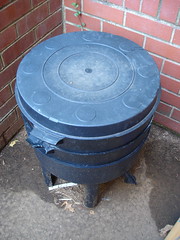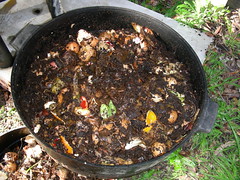| Worm farm bin |
The first thing to consider is how big of a container you're going to need. To figure this out, you'll need to first measure out approximately how much waste you are going to need to use for feeding. For each pound of waste, you'll need one square foot of space in your bin. Depth should be at least six to twelve inches.
A plastic tote or container works well as do wooden boxes. Metal containers should not be used as irons and chemicals can leach into the soil, harming the worms. Many worm farmers prefer wooden boxes over plastic as wood is more easily aerated. Plastic can cause more moisture to build up than wood, which can be both good and bad.
Once a container of the appropriate size has been chosen, it'll need to be prepared. Holes should be drilled or punched through the top of the container to allow for air flow. There are two ways to address the bottom of the container.
One method is to drill or punch holes into the bottom of the container to allow excess water and other liquids to drain out. Another is to install a spout at the bottom of the container. When liquid begins to fill up in the bottom, the spout is turned on and releases the fluid.
If using a spout, a raised shelf should be added within the container. This shelf should be the same width as the container, but be allowed to sit a few inches above the bottom. This will allow the empty space at the bottom to fill with liquid and prevent it from sitting in the soil and bedding. This raised shelf should be made of slats or have several holes to allow liquids to drain into the bottom of the container.
If a raised shelf is not used, screening should be installed over the holes to allow liquid to run out of the container but prevent worms from squeezing through. Screening should also be attached to the top of the container to prevent escape.
| Top layer of a worm farm (Photo credit: Doug Beckers) |
The container should be put in a location that will ensure optimal conditions. Temperature should remain between 72 and 75 degrees Fahrenheit. The bin should not be placed in an area of the yard that will gain excess rain water, either.
Once the bin has been constructed, bedding has been added and the perfect location has been found, the next step is to add the worms and begin your own worm farm. Worm farming is rewarding whether it is done for a profit or a hobby. Constructing an appropriate home for these guys is your first step towards becoming an authentic worm farmer.
For what to feed your worms, be sure to check back on Thursday!
Worm Farming Resources:



No comments:
Post a Comment